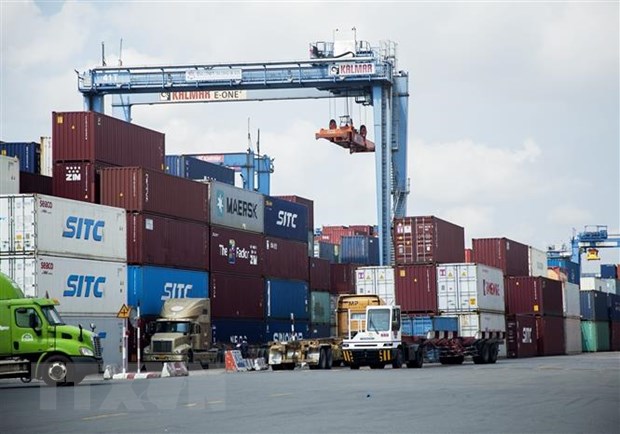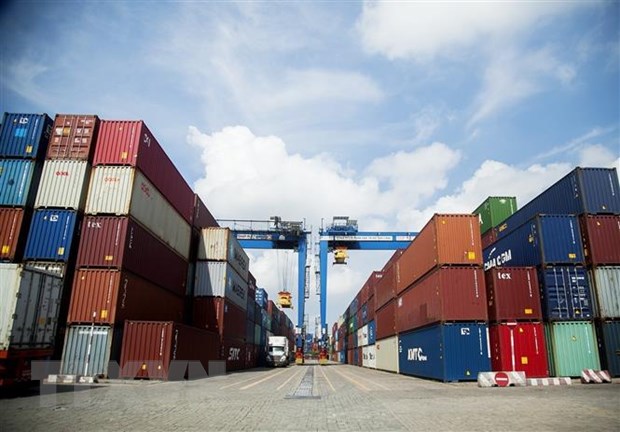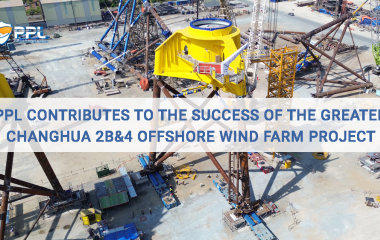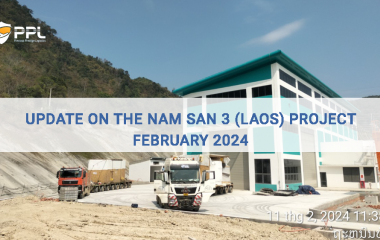Economic development in the Southeast region: Removing logistics "bottlenecks"
The Southeast region handles most of the cargo volume and container volume of the country, but currently, there are many "bottlenecks", notably infrastructure, an important issue affecting logistics activities.
Infrastructure bottlenecks and no suitable mechanism are the bottlenecks that need to be removed for logistics development (logistics services) in the Southeast region.
The above content was raised at the Workshop "Logistics in the Southeast: Sharing and Perspectives from Experts," jointly organized by the Center for Trade and Investment Promotion of Ho Chi Minh City and the International Arbitration Center. Vietnam and the Ho Chi Minh City Logistics Association held a ceremony on the morning of November 23 in Ho Chi Minh City.

Cat Lai Port (Ho Chi Minh City) is one of the international transshipment gateways.
Traffic jams
According to statistics, the Southeast region has about 14,800 logistics service providers, accounting for 49.2% of the total number of logistics enterprises in the country.
The number of logistics enterprises is concentrated mainly in Ho Chi Minh City with more than 11,000 enterprises, Binh Duong province has nearly 1,700 enterprises and Dong Nai has more than 1,200 enterprises.
Not only playing the role of the economic locomotive, but the Southeast region is also an area where important logistics infrastructure is concentrated, taking on most of the volume of goods and volume of container cargo in the country.
Efficiently use resources to promote the import and export of goods
However, the Southeast currently has many "bottlenecks", notably infrastructure, an important issue affecting logistics activities.
According to Huynh Van Cuong, Vice Chairman of the Ho Chi Minh City Logistics Association (HLA), and Chairman of the Board of Directors of Saigon Port Joint Stock Company, this is a "bottleneck" leading to many challenges for logistics businesses.
Road transport infrastructure has not yet met the demand because the roads are small and narrow, and the load is limited (especially for containers and construction goods); Too many intersections cause congestion and traffic conflicts.
"While road traffic has not yet met the appropriate load for goods trade, connecting the port with industrial parks, factories, and warehouses, multimodal transport has not been effective because of the lack of connection between the roads. The investment in these modes is not synchronized, often warped, and lacks consistency in both objectives and implementation time plan," said Mr. Cuong.
The whole region currently has only the Ho Chi Minh City-Long Thanh-Dau Giay Expressway. The planning projects of the ring road and connecting traffic axis are slow to implement.
In terms of waterways, the region has six inland routes, but many river crossings on the main routes do not guarantee static space and navigable compartments (Binh Trieu bridge, Binh Phuoc bridge).
With Ho Chi Minh City, the belt routes connecting with the Southeast and Southwest provinces have not been properly invested, negatively affecting two-way traffic and freight.
The road system, especially belt system 2, belt 3, and belt 4, is incomplete; often congested roads to Cat Lai port, Truong Tho ICD.
Tan Son Nhat airport is overcrowded, the airport terminals are at full capacity.
According to Mr. Nguyen Cong Luan, Deputy Head of the Import-Export Management Department (Ho Chi Minh City Department of Industry and Trade), logistics activities in Ho Chi Minh City are facing many obstacles, prominent among them is the current status of logistics activities. Infrastructure.
Ho Chi Minh City is both a large consumer market and the largest distribution center in the country.
However, the lack of logistics centers that fully meet the criteria can cause certain bottlenecks for logistics traffic in the long run.
Need more mechanisms
Mr. Nguyen Thanh Tuan, Head of Research at Vietnam Logistics Research and Development Institute (VLI), said that logistics in the Southeast region still has many backlogs and limitations, requiring timely remedial measures.
Through the survey and statistics, it can be seen that the current development of logistics services is somewhat disproportionate to the potential, regional advantages, logistics costs are still high, and the connection between logistics service enterprises, import and export enterprises export has not been as effective as expected.

Warehousing infrastructure in Vietnam's logistics industry has undergone rapid changes in recent years but has not been as effective as expected.
Resolution 24-NQ/TW dated October 7, 2022, of the Politburo on socio-economic development and assurance of national defense and security in the Southeast region to 2030, with a vision to 2045 also points out the regional development bottlenecks.
That is, the network of regional and inter-regional infrastructure, especially the transport infrastructure connecting the region and the inter-region, is still lacking, weak, and inconsistent; high-quality logistics human resources have not yet met the demand; logistics costs are still high; the association between production-import enterprises and logistics enterprises with low efficiency; Large-scale logistics centers have not yet been established, playing the role of regional multimodal transshipment of goods.
According to Mr. Huynh Van Cuong, in order to solve these problems, over time, each locality has proposed and implemented many plans and strategies with the goal of improving logistics activities and strengthening regional logistics connectivity.
However, connecting regional infrastructure is a difficult problem, requiring localities to join hands, and promote their local potential along with contributing initiatives to improve and promote activities. The most favorable regional logistics.
Agreeing with this view, the Head of the Research Department of Vietnam Logistics Research and Development Institute Nguyen Thanh Tuan suggested: "It is necessary to take into account the common interests of the whole region rather than the interests of the locality. transport infrastructure, which focuses on developing the network of highways and ring roads of Ho Chi Minh City."
Mr. Nguyen Thanh Tuan also suggested some policy implications for the development of the logistics industry in the Southeast region. It is the state management agency that promulgates a mechanism to mobilize resources from the private sector, land, etc. to have a budget for infrastructure development and has policies to promote regional linkage, a mechanism especially and coordination among provinces.
Meanwhile, businesses need to increase technology applications to digitize transportation journey data and apply automation in the field of logistics from shipping, port services, warehousing, and transportation...
Modernize management and operation methods, use software systems and logistics optimization platforms to cut logistics costs, and improve service delivery quality and efficiency.
At the workshop, the delegates also exchanged and proposed research on synchronous, strong, and feasible mechanisms and policies to diversify investment forms to promote socio-economic infrastructure development. especially the formation of new financial institutions.
According to the announcement of the Vietnam Logistics White Paper 2018, currently, Vietnam's logistics service industry has more than 3,000 businesses operating professionally; in which, 54% of Ho Chi Minh City and the demand for logistics human resources is very large. Delegates analyzed and forecast that by 2030, the demand for professional human resources for the whole industry would be 200,000 employees, while the ability to meet the demand would only reach about 10%.
Therefore, enterprises need to focus on improving the training and recruitment of logistics human resources.
In 2022, the global logistics market has recovered and entered a new phase with the expectation of bringing significant growth for the whole year.
However, experts also noted that with the volatile situation of the world at the moment as well as in the future, logistics enterprises need to be more proactive and prepare better strategies to meet the demand. market; at the same time, maintaining sustainable business operations.
Related Posts
New Posts
- Vietnam Holiday Announcement
- PPL contributes to the success of the Greater Changhua 2b&4 Offshore Wind Farm Project
- Update on the Nam San 3 (Laos) Project February 2024
- PPL HAPPY NEW YEAR 2024
- LUNA NEW YEAR HOLIDAY 2024 ANNOUNCEMENT
- PPL CONDUCTS A CHARITY PROGRAM OF FREE MEDICAL EXAMINATIONS, CONSULTATIONS, AND MEDICATION DISTRIBUTION IN THAI BINH PROVINCE







Comments